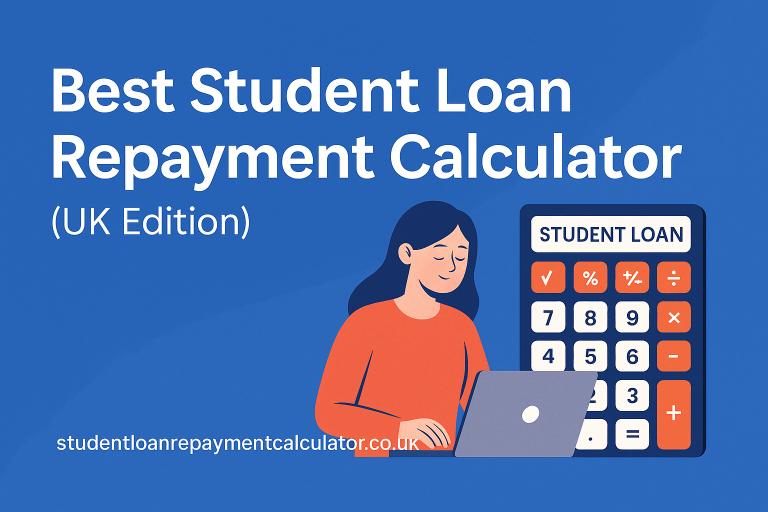The Student Debt Repayment Calculator estimates payments and interest costs, considering UK loan types, interest rates, term lengths, and income changes. It compares options like Plan 1, Plan 2, and Postgraduate Loans, addressing income adjustments, employment status, and effective debt management strategies.
Student Debt Repayment Calculator

When it comes to managing student debt repayment, utilising a student debt repayment calculator is vital for strategic financial planning. These calculators factor in key aspects like loan amount, interest rate, term length, and various repayment plans to provide accurate estimations on monthly payments and total interest paid. Understanding the types of loans and interest rates becomes essential to grasp the intricacies of total repayment costs. In addition, these tools aid in analysing income adjustments, multiple loan repayment strategies, and the impact of employment status on repayment calculations. Student debt repayment calculators serve as indispensable assets in steering through the complexities of managing student loans efficiently.
Loan Repayment Estimation
When estimating loan repayment, it is imperative to utilise accurate and thorough tools for financial planning. By utilising a student loan repayment calculator, individuals can estimate monthly payments, budget for educational expenses, and compare different loan options. this tool provide insights into total interest paid over the loan period and aid in enhancing financial planning for future education costs. Key features of this calculator include input fields for loan amount, interest rate, and term length, calculation of monthly payment amounts, breakdown of principal vs. interest, and options for different repayment plans.
Advanced Budget Planning Tool
To effectively manage student loan debt, it is imperative to utilise advanced budget planning tools that go beyond simple estimations. An advanced budget planning tool offers a thorough overview of your finances, allowing for a detailed analysis of income, expenses, and potential savings. By incorporating factors such as monthly living costs, unexpected expenses, and variable income sources, this tool provides a more accurate representation of your financial situation.
Additionally, advanced budget planning tools can help you forecast future scenarios and make informed decisions regarding your student loan repayment strategy. By considering various repayment plans, interest rates, and potential changes in income, you can create a proactive financial plan that aligns with your long-term goals.
Furthermore, these tools enable you to track your progress, adjust your budget as needed, and stay on top of your financial responsibilities. Overall, utilising an advanced budget planning tool is essential for developing a sustainable repayment plan and achieving financial stability post-graduation.
Early Financial Strategy Benefits
Exploring the realm of early financial strategy benefits reveals the paramount importance of proactive planning in navigating the intricate landscape of student loan repayment. By commencing financial planning early, individuals can gain a competitive advantage in managing their student debt burden efficiently. Early strategic planning enables borrowers to foresee potential challenges, explore various repayment options, and tailor a repayment approach that aligns with their financial objectives.
Moreover, proactive financial strategising empowers borrowers to anticipate future income fluctuations, assess the impact of interest rate changes, and make informed decisions regarding loan repayment. Understanding the intricacies of student loan terms, repayment plans, and interest rates early in the process equips borrowers with the knowledge needed to navigate the repayment journey successfully.
Embracing early financial strategy benefits not only fosters a sense of financial security but also lays a solid foundation for long-term financial well-being post-graduation. By taking proactive steps towards managing student debt, individuals can alleviate financial stress and pave the way for a more stable financial future.
Repayment Plan Details
An in-depth examination of the intricacies of student loan repayment plans reveals important details that borrowers must grasp to navigate the repayment process effectively. Repayment amount calculations are primarily based on pre-tax income and deductions, with different thresholds for each plan type. Monthly repayments are determined as a percentage of income over the threshold, such as Plan 1 requiring a £30,000 income resulting in a £60 monthly repayment. Income changes can impact repayment, triggering adjustments or refunds based on exceeding or falling below the threshold. Understanding interest rates by plan type is essential, with rates varying from 4.3% for Plans 1, 4, and 5 to 7.3% for Postgraduate Loans. When dealing with multiple loan plans, repayments are based on the lowest threshold, simplifying the process. Employment status also plays a significant role, especially for self-employed individuals whose repayments are calculated from annual tax returns. Grasping these repayment plan intricacies is important for borrowers seeking to manage their student debt effectively.
Income Adjustment Considerations
Considering adjustments to income is a significant aspect of managing student loan repayments effectively. When income fluctuates, whether due to bonuses, overtime, or changes in employment status, it can impact the amount you are required to repay. If your income exceeds the threshold set by your repayment plan, you may need to make higher payments. Conversely, if your income falls below the threshold, you might be eligible for refunds. It’s important to track income changes accurately to ensure your repayments align with your financial situation. Understanding how different income levels affect your repayment obligations is essential for staying on top of your student debt. By staying informed about income adjustments and their implications for your loan repayments, you can navigate the repayment process more effectively and make strategic financial decisions.
Interest Rate Impact Analysis
Analysing the impact of interest rates on student loan repayments is essential for understanding the total cost of borrowing and planning for effective repayment strategies. The interest rate directly influences the amount of money paid back on top of the initial loan. A higher interest rate means higher overall repayment costs, while a lower rate can lead to savings over the loan term. It’s vital to take into account whether the interest rate is fixed or variable, as variable rates can fluctuate, potentially affecting monthly payments unpredictably.
Understanding how interest rates compound and accrue over time is key to estimating the total repayment amount accurately. Even a small percentage difference in interest rates can translate to significant changes in the total amount repaid. By comparing interest rates from different lenders and loan products, borrowers can make informed decisions that align with their financial goals and capabilities. Effective management of interest rates can lead to substantial savings in the long run.
Multiple Loan Repayment Strategies
Moving from the examination of interest rate impacts on student loan repayments, it becomes imperative to discuss the strategies involved in managing multiple loans simultaneously. When dealing with multiple loans, prioritising repayment based on interest rates can lead to significant cost savings. By allocating more funds towards higher interest loans while making minimum payments on others, borrowers can reduce the overall interest paid. Another effective strategy is debt snowballing, focusing on paying off the smallest loan first to gain momentum and motivation. Consolidation loans can also streamline repayment by combining multiple loans into one, potentially lowering the monthly payment amount. Additionally, staying organised with a repayment plan that outlines each loan, its terms, and monthly payments can help avoid missed deadlines and penalties. Understanding these multiple loan repayment strategies is essential for borrowers aiming to efficiently manage and eventually overcome their student debt burden.
Employment Status Effects
In understanding the impact of employment status on student loan repayment, it is essential to recognise how different job situations can influence the financial obligations of borrowers. Self-employed individuals have repayments calculated from annual tax returns, with HMRC deducting any prior salary repayments from the total owed. In cases where borrowers have multiple jobs, each job is assessed individually for repayment thresholds. For instance, under Plan 1, having two jobs below the threshold may result in no repayments, while under Plan 2, only the higher-paying job contributes to repayments. This distinction highlights the importance of understanding how employment status can directly affect the repayment amounts and strategies borrowers need to take into account. Being aware of these nuances can greatly impact financial planning and the ability to manage student debt effectively.
Conclusion
In summary, utilising the Student Debt Repayment Calculator is essential for navigating the complexities of student loans and debt repayment. By estimating monthly payments, comparing loan options, and simulating payment scenarios, we can make informed decisions about our educational finances. With early planning and strategic repayment approaches, we can secure a stable financial future post-graduation. Let us embrace financial literacy and responsible debt management, leveraging this tool as our trusted ally in the realm of student loans.


